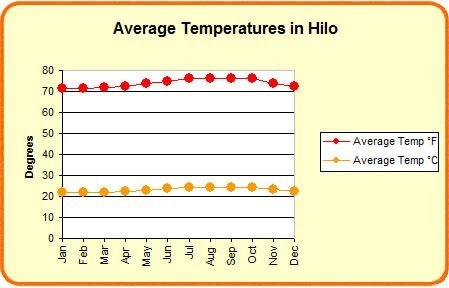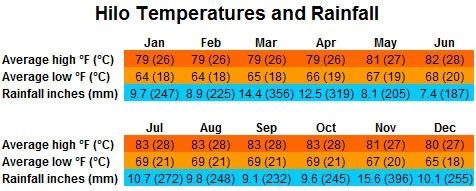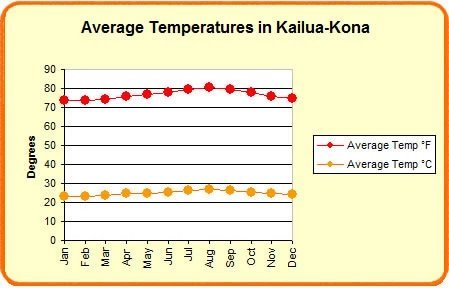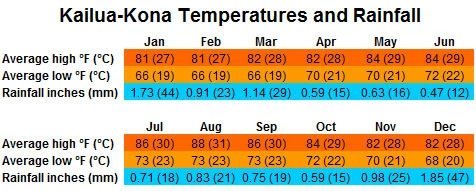Big Island of Hawaii Weather
The Big Island of Hawaii experiences the most diverse weather of any Hawaiian island, with 10 of the world's 15 climate zones. The east side (Hilo) is lush and rainy, while the west side (Kona) is dry and sunny. Elevation also impacts temperature, with cooler climates in upcountry towns and snowy conditions on Mauna Kea. These unique conditions contribute to the Big Island's dramatic landscapes and rich biodiversity.
Generally speaking and from a visitor's point of view, the weather on the Big Island divides the island in half. The Hilo side (east side of the island) is much wetter than the Kona side (west side of the island). Most people associate Hilo with rain. In fact, Hilo is the wettest city in the United States (no, it's really not Seattle!). On average, the city receives about 130 inches (3302 mm) of rain per year. Most of the rain falls at night and early morning, and daytime showers are usually intense, but short-lived.
But the advantage of all the rain on the Big Island's east shore is that it's so green. Hilo can be described as one big natural greenhouse, with blooming flowers, waterfalls and tropical foliage everywhere. The green surroundings, dark lava rocks on the shore and deep blue ocean make for a picture-perfect sight (when the sun is shining). Kona, on the other hand, is so dry that there are no waterfalls or streams here and the scenery is rather barren and by far not as lush as the Hilo side.
However, since not all rain gets absorbed into the ground and also flows into the ocean, this so-called runoff makes the ocean look darker and murkier on the Hilo side. That's why the snorkeling and diving conditions on the Kona side of the island are far superior to the Hilo side. The Kona side also has more sandy beaches than the Hilo side, which has a predominantly rocky shoreline.


The Kona side of the Big Island is dry and sunny on most days of the year. That's why most hotels and resorts on the island are located here because visitors prefer sunshine. The Kohala area (located north of Kailua-Kona) is the driest area on the island, receiving just about 10 inches (254 mm) of rain per year. When it rains here, it usually rains in the late afternoons and evenings.


Even though the main difference between Hilo and Kona is the amount of rain, when it comes to the temperatures there isn't much difference. The year-round average temperature in both cities is around 74°F (23°C). It's cooler in Waimea (Kamuela), which is located at an elevation of about 2,670 feet (814 m). Here the average year-round temperature is around 70°F (21°C). The temperature in the town Volcano, which is at the entrance to the Hawaii Volcanoes National Park at about 3,800 feet (1,158 m), hovers around 60°F (15.5°C), while the summits of the Big Island's tallest mountains, Mauna Kea and Mauna Loa, are usually about 30°F cooler than the coastlines.
The Big Island's average ocean temperature is around 75°F (24°C) in February and 82°F (28°C) in September. The water can be a bit colder in areas where freshwater springs bubble up from the ocean bottom, such as for example at Carlsmith Beach Park or Ice Pond in Hilo.
Big Island of Hawaii climate
No other island in the state of Hawaii experiences such a variety in weather and climate zones as the Big Island. In fact, according to the widely used Köppen Climate Classification System, the Big Island has 10 of the 15 climate zones in the world, which is quite amazing. It is difficult to think about another place in the world of equal size that is home to that many different climates.
On the Big Island, you'll find everything, from tropical and desert, to monsoonal, periglacial and other climates. On no other Hawaiian island (and in only very few other places in the world) can you walk in snow in the morning on top of a tall mountain and in the afternoon go swimming in the ocean and sunbathe on a tropical beach. This is what makes the Big Island of Hawaii a truly unique place.
Volcanic smog (vog) on the Big Island
A common natural phenomenon on the Big Island is vog (volcanic smog). Since the island is home to Kilauea, an active volcano, the eruptions produce vog. Kilauea's Pu'u O'o vent spews out about 200 tons of sulfur dioxide and other toxic fumes each day. Thanks to the tradewinds a lot of these fumes are quickly blown out to sea. Areas around the Hawaii Volcanoes National Park and the Big Island's Kona Coast are the most affected by this vog.
Vog makes the air and sky look hazy and can cause problems for people who suffer from asthma or other breathing problems. For those people it is best to avoid vog-prone areas or to stay indoors when the vog is thick. Since the tradewinds generally blow from the northeast, the vog is thicker on the Kona side of the island.
Frequently Asked Questions about Big Island Weather
Why is Hilo wetter than Kona?
Hilo is on the windward (east) side of the island, receiving moist tradewinds that bring heavy rainfall. Kona, on the leeward side, is sheltered and stays dry and sunny most of the year.
What is the driest area on the Big Island?
The Kohala Coast, north of Kailua-Kona, is the driest, averaging only 10 inches (254 mm) of rain annually, making it ideal for beachgoers and resorts.
Can it snow on the Big Island?
Yes, Mauna Kea and Mauna Loa occasionally receive snow at their summits during winter due to their high elevation, over 13,000 feet above sea level.
What is vog and where does it affect the island?
Vog is volcanic smog from Kilauea's eruptions. It can reduce air quality, especially on the Kona side, and may cause issues for people with respiratory conditions.
What is the average ocean temperature around the Big Island?
The ocean temperature ranges from around 75°F (24°C) in February to 82°F (28°C) in September, with cooler pockets where freshwater springs enter the sea.








